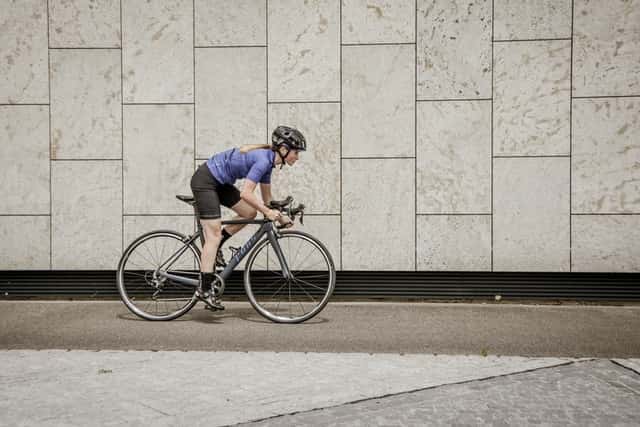There is a long-running debate in the cycling community about stiff cycling shoes and if they really do offer the rider an advantage over those who prefer to wear softer soles.
When it comes to a successful bike ride, especially one that covers lots of difficult and uneven terrain, a rider’s primary concern is the quality of their performance, something that depends on the cycling shoes you wear more than people might think.
Another long-running debate in the cycling community concerns whether or not you should wear clipless shoes for an improved cycling performance.
Clipless shoes can be clipped right into the bike’s pedals, so there is a lot to be said for the increase in support and grip that the rider has while wearing them.
This debate seems to lean heavily in favor of clipless shoes over shoes that don’t clip themselves into the pedals because the extra grip takes the pressure off your knees as you cycle, allowing for a smoother pedaling motion.
But the debate concerning whether or not stiff cycling shoes make a difference to your performance is still ongoing, with opinions both for and against them.
Stiff-soled shoes aren’t comfortable for walking or running, but cycling is an entirely different matter. When it comes to performance on a bike, there are three big things to consider: pedaling, stamina and stability.
You’ll see an improvement in your stamina the less that you exert yourself on the bike, particularly while you pedal, and the more stable you feel, the more force you’ll be able to put into pedaling.
There are several main benefits of choosing to wear stiffer cycling shoes for a bike ride, especially if you are a regular cyclist who likes to explore lots of different routes.
The Benefits of Stiffer Cycling Shoes
Force
A lot of research has been done about stiff-soled cycling shoes and how much of a difference they make to a rider’s overall performance, and one of the top findings has been to do with the amount of force that the rider can transfer onto the pedals.
The stiffer the soles, the more power a rider can put into the pedaling motion, forcing it down firmly.
If the soles of the cycling shoes are softer, they will flex around the shape of the pedal, molding to it instead of pushing against it, flat surface to pedal surface.
The stiffer the sole, the more solid it is, and the more solid it is, the more secure it will feel on the pedal. A stiff shoe sole is an entire surface that will not bend in any way around the pedal.
Shoes with increased flexibility are ideal for running because your foot needs to flex and bend, but with cycling, you need to push the flat of your foot firmly down on the pedal continuously to achieve the ideal motion.
A stiff sole will make your foot flatter on the pedal, pushing more force into the motion. The more forceful your pedaling, the further your bike will go.
Grip
The grips on shoe soles don’t necessarily depend on how stiff or soft the shoe is, but a stiffer sole can definitely feel more comfortable and secure while your feet are poised in the pedaling position.
A more flexible shoe may also have good grip, but the softness of the sole will mold to the pedal, making your pushes less powerful.
A stiff sole will grip firmly to the pedal as you push down on it, so your shoe shouldn’t slip in any way or make excessive contact with the pedal.
Stiffer soles are also less likely to be ‘worn in’, which means that they’ve also molded to the shape of your feet.
This will help you to maintain the flat foot position that is required to put optimal pressure into the downward motion of pedaling, which will use up less energy.
If your foot is bending around the pedal because your cycling shoes aren’t stiff enough, you won’t feel like you have enough grip.
The relationship between grip and power is obvious, especially when it comes to cycling uphill, so stiff-soled cycling shoes are ideal for getting your foot just right in the most secure position when you pedal.
Stability
Similar to having a better grip, stiff-soled cycling shoes will also improve your overall stability on the bike.
The ideal riding posture is a straight back with your hands supported on the handlebars, reducing strain on the neck and shoulders. However, the stability for this position begins with how your feet sit on the pedals.
If your shoes have soft soles that mold around the pedals, you’ll need to put more force into pedaling, which will tire your legs and have your upper body slumping in the saddle to put extra force into the pedaling motion.
The power that you can put into each rotation when you have your feet completely flat in stiff-soled shoes will allow you to separate your upper body from your lower body throughout the ride.
If your feet are secure enough to pedal without taking too much energy from your legs, you won’t need to move your upper body to push more into the downward motions.
Your upper body can do the work of steering the bike and your legs can transfer energy to your feet, which are constantly held stable and flat on the pedals in stiff-soled shoes.

Stamina
Studies into stiff-soled cycling shoes have also investigated the exertion that comes with a given power output when you pedal, finding that the stiff soles actually result in less exertion for the cyclist, which will help them to maintain their stamina throughout the ride.
The more effort it takes to pedal, the more you’ll exert your legs, which will then cause you to funnel excessive energy into simply rotating the pedals.
This is counterproductive because a single bike ride will exert your body and increase the time it takes for your muscles to recover.
If you want to complete several rides in a short period of time or cycle long-distance, this will be a problem.
One of the biggest threats to the stamina of a cyclist is hills; however, stiff cycling shoes have been found to improve uphill cycling because they increase the amount of force and power that you can put into each pedaling motion. The stronger each individual motion, the less movement required by the rest of the body.
Stiff-soled shoes are designed to sit perfectly on the flat surfaces of bike pedals, which gives the rider an advantage over others who don’t have such stability.
The more stable you are, the greater the output of power per pedal, which allows you to maintain your stamina and focus on remaining in the proper riding position.
Potential Downsides
Less Comfortable For Walking
A rider’s first priority is how well shoes will serve their feet when they cycle, so cycling shoes are not designed to be comfortable when worn off a bike.
As a result, you might not be able to walk around much when you take a break during a ride, or you’ll have to pack an extra pair of shoes for when you want to stretch your legs.
Soft-soled shoes are ideal for this, especially since stiffer cycling shoes restrain your feet and prevent you from stretching them out much.
However, if you prefer to travel light, you’ll have to find somewhere to store your extra shoes, especially since taking a short walk on your breaks is important for allowing your body to recover from being in the saddle.
Performance May Dip If Shoes Become Less Stiff
Stiff cycling shoes are designed to stay stiff as you ride, but, as with any other shoes, you might notice the quality of them starting to decline after a lot of use.
If your cycling shoes start to become less stiff, you might not see the same level of performance as you did before.
This is all to do with the amount of force and power that you can put into pedaling, and the weaker your pushes become, the less energy you will transfer from foot to pedal.
Keeping your cycling shoes as stiff as they are when new is the best way to maintain performance, especially if you ride regularly, so you may need to replace your shoes if you notice the soles starting to soften and flex.
Recommended Product: Giro Stylus Mens Road Cycling Shoes ( Amazon Link )
How Stiff Should Cycling Shoes Be?
Cycling shoes range from a stiffness index of 6 to 10, with stiffness increasing slightly with the numbers. The average cyclist will only need shoes with a stiffness index of 6 because those shoes will provide enough stiffness for general cycling.
If you are more of a seasoned cyclist, you might want to try shoes with a stiffness index of 7 or 8 because these will have stiffer soles that will help you to tackle trickier routes with more power.
And if your cycling performance is extraordinary or you cycle competitively, a stiffness index of 9 or 10 is perfect for ensuring that you perform to the best of your abilities every time.
You should choose a shoe stiffness that corresponds to your cycling capabilities.
For instance, a stiffness index of 9 might be too high for a casual cyclist who mainly rides on smooth terrain because a stiffness index of 6 is perfectly suited for that level.
Though a stiffness index of 9 or 10 will guarantee optimal energy transfer to the pedals for powerful rotations, it is simply unnecessary for cyclists who won’t need to use that much power.
A stiffness index of 6 is still stiff, so you won’t be losing out by opting for less stiff shoes because they’ll suit your abilities better.
Drawing A Conclusion
Stiffer cycling shoes do make a difference when it comes to the integral components of a rider’s performance on a bike, particularly in terms of uneven surfaces or uphill routes that require an increase in strength and are more likely to drain energy.
The stiffness of the sole will allow the foot to sit completely flat on the pedal, putting it in the best position to push down hard without exerting the legs or upper body.
This happens because a flat foot can put more power into a downward motion than a flexed foot can, and your feet are far more likely to be bent or flexed in a soft-soled shoes.
A lot of cycling shoes are designed with stiff soles, just as many are designed to be clipless and improve your grip on the pedals.
Stiffer cycling shoes will put your feet in the optimal position to do their job as you cycle, which will take the pressure off the rest of your body, especially if you are navigating new and difficult terrain.
If you often find your feet sore from making contact with the pedals or your legs tired out by excessive pushing, you should try stiff-soled cycling shoes because they will help your feet to transfer increased energy and force into pedalling, improving your overall performance.









Leave a Reply